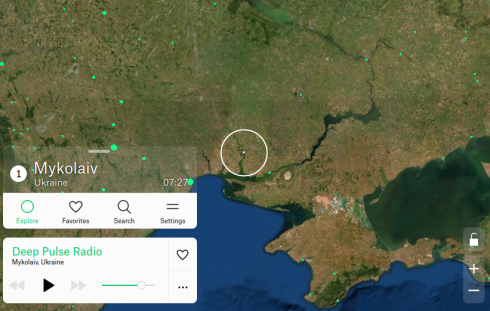
A wonderful website where you can peruse the world and hear local radio stations as you go.
Middle and High School … from a Montessori Point of View

A wonderful website where you can peruse the world and hear local radio stations as you go.
Pluck a string on a guitar and the sound you hear depends on how fast it vibrates. The frequency is how many times it vibrates back and forth in each second. An A4 note has a frequency of 440 vibrations per second (one vibration per second is one Hertz).
The vibration frequency of a guitar string depends on three things:
Guitar string sets come with wires of different masses. The guitar has little knobs on the end for adjusting the tension. For building the guitar, you have the most control over the last last parameter, the length of the string, which is called the scale length. Since the guitar string masses are pretty much set, and the strings can only hold so much tension, there are limits to the scale length you can choose for your guitar.
In a guitar, the scale length only refers to the length of the string that’s actually vibrating when you pluck the string, so it’s the distance between the nut and the bridge. For many guitars this turns out to be about 24.75 inches.
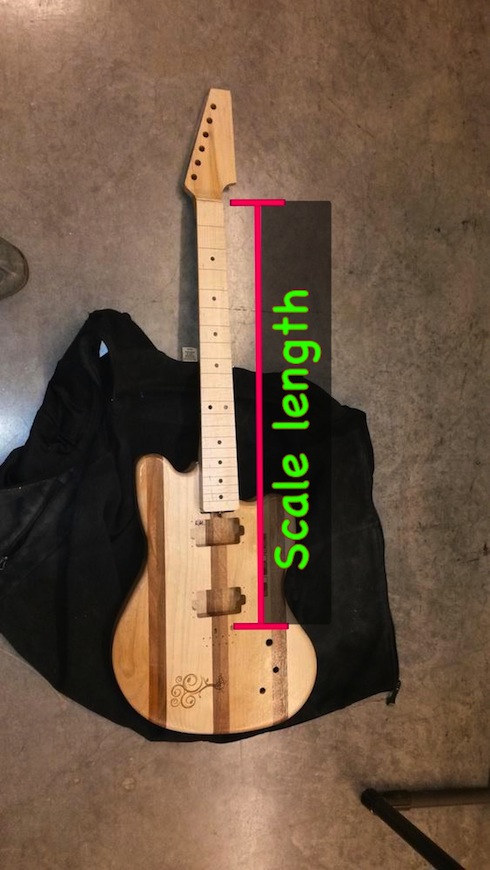
To play different notes, you shorten the vibrating length of the string by using your finger to hold down the string somewhere along the neck of the instrument. The fret board (which is attached to the neck) has a set of marks to help locate the fingering for the different notes. How do you determine where the fret marks are located?
Well, the music of math post showed how the frequency of different notes are related by a common ratio (r). With:
![]()
So given the notes:
| Note Number (n) | Note |
|---|---|
| 0 | C |
| 1 | C# |
| 2 | D |
| 3 | D# |
| 4 | E |
| 5 | F |
| 6 | F# |
| 7 | G |
| 8 | G# |
| 9 | A |
| 10 | A# |
| 11 | B |
| 12 | C |
Since the equation for the frequency of a note is:
![]()
we can find the length the string needs to be to play each note if we know the relationship between the frequency of the string (f) and the length of the string (l).
It turns out that the length is inversely proportional to the frequency.
![]()
So we can calculate the length of string for each note (ln) as a fraction of the scale length (Ls).
![]()
substituting for fn gives:
![]()
but since we know the length for f0 is the scale length (Ls) (that inverse relationship again):
![]()
giving:
When we play the different notes on the guitar, we move our fingers along the neck to shorten the vibrating parts of the string, so the base of the string stays at the same place–at the bridge. So, to mark where we need to place our fingers for each note, we put in marks at the right distance from the bridge. These marks are called frets, and we’ll call the distance from the bridge to each mark the fret distance (D_n). So we reformulate our formula to subtract the length of the vibrating string from the scale length of the guitar:
The fret marks are cut into a fret board that was supplied by the guitarbuilding team, which we glued onto the necks of our guitars. We did, however, have to add our own fret wire.
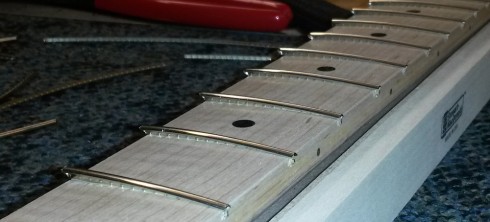
The team also has an activity for students to use a formula (a different one that’s recursive) to calculate the fret distance, but the Excel spreadsheet fret-spacing.xls can be used for reference (though it’s a good exercise for students to make their own).
Mark French has an excellent YouTube channel on Mechanical Engineering, including the above video on Math and Music. The video describes the mathematical relationships between musical notes.
Given the sequence of notes: C, C#, D, D#, E, F, F#, G, G#, A, A#, B, C.
Let the frequency of the C note be f0, the frequency of C# be f1 etc.
The ratio of any two successive frequencies is constant (r). For example:
![]()
so:
![]()
We can find the ratio of the first and third notes by combining the first two ratios. First solve for f1 in the first equation:
![]()
solving for f1,
![]()
now take the second ratio:
![]()
and substitute for f1,
![]()
which gives:
![]()
We can now generalize to get the formula:
or
where,
- n – is the number of the note
From this we can see that comparing the ratio of the first and last notes (f12/f0) is:
![]()
Now, as we’ve seen before, when we talked about octaves, the frequency of the same note in two different octaves is a factor of two times the lower octave note.
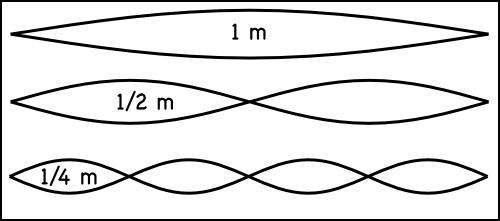
So, the frequency ratio between the first C (f0) and the second C (f12) is 2:
![]()
therefore:
![]()
so we can now find r:
![]()
![]()
Finally, we can now find the frequency of all the notes if we know that the international standard for the note A4 is 440 Hz.
Mark French has details on the math in his two books: Engineering the Guitar which is algebra based, and Technology of the Guitar, which is calculus based.
This week I’m learning how to build an electric guitar–from scratch (or almost). Tom Singer, a professor in design and manufacturing at Sinclair Community College in Dayton, Ohio, is the lead on an NSF funded project to bring guitar building into schools.
I may have a tin ear when it comes to music, but there is quite the interest in guitar playing at the Fulton School at the moment–all the way from the elementary kids to the high schoolers–so I thought it would be a good catch-the-imagination mechanism for use in math and science.
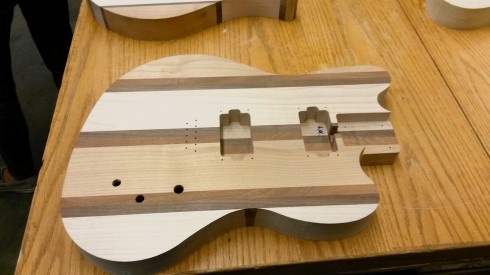
First we got to choose a guitar body. The guitarbuilding team had a fair collection of guitar shapes for the group in the workshop to choose from. The shapes are cut from 1.75 inch thick woo. To get the elegant layered patterns you see above, they laminate about half a dozen different types of wood. This may make for beautiful guitars, but the different densities and hardnesses of the wood have to be considered when working with them. The darker colored woods in the guitar body above were much harder to shave and sand than the lighter colored material.
Note to self: Indeed, if I remember to get hold of some scrap pieces of the different woods, I can probably make up a nice density measuring project. Indeed, it would be nice to have students graph the relationship between density and hardness. Wood hardness is measured on the Janka scale. I suspect there is a positive relationship, but I’d like to see if we could determine the shape of the curve.
Not all of the guitar bodies are beautiful laminates, however. Some, of a single type of wood, are the best candidates for painting. Others are hollowed out, and can be played acoustically as well as plugged in.
Today I learned what a fretboard is. Apparently it’s a separate piece with the gradational markings that’s attached to the neck.
The necks were all of maple, if I remember correctly, but the fretboards were made of different types of wood. Each was a single piece of wood, but the wood’s hardness and affects the “brightness” of the sound produced by the guitar.
So now it’s time to sculpt and sand the body, and put all the pieces together.
“My life would be worthless without music.”
— Young Paraguayan violinist.
The Fulton School has a wonderful music program, so I’m hoping that this video, about how Paraguayan children living in a slum on a landfill have recycled classical instruments out of the trash, resonates with some of my environmental science students.
Landfill Harmonic film teaser from Landfill Harmonic on Vimeo.
Of course, we’ve seen other instruments invented out of discarded trash. The BBC has a brief history of the steel pan, but Trinbagopan.com has an much more detail. On the other hand, I prefer my history in a musical form.
Take randomly generated sound waves (using sine curves for example), mix them together to get beats, and then let people decide which ones sound best. Let the best ones mate — add in small mutations — and wait a few thousand generations for the sound patterns to evolve into music.
That’s what DarwinTunes does, and they let you participate in the artificial selection process (artificial as opposed to natural selection).
The details are included in their article: Evolution of music by public choice by MacCallum et al. (2012).
Beethoven – Ode to Joy
Time to recharge.
Tool‘s Lateralus has the Fibonacci Sequence embedded into it. Ms. Wilson tells me that some of her Algebra II students were able to detect it out after listening to the song (a few times), but this video has the highlights where the sequence occurs.
↬ Ms. Wilson